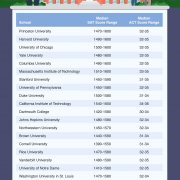What Is the ACT?
The ACT and the SAT are the two standardized admissions tests accepted by four-year colleges in the U.S. (Learn about the SAT here.) All four-year colleges that require admissions tests as part of the application process will accept either the ACT or the SAT.
The ACT is designed to evaluate college readiness by testing students’ knowledge in four key subject areas: English, reading, science, and math. The ACT focuses on evaluating academic achievement rather than aptitude. ACT has conducted numerous validity studies that have found that ACT scores evaluated in conjunction with high school GPA accurately predict college performance.
When to Take the ACT
We recommend that most students first take the ACT by spring of junior year. This ensures that students will have addressed most of the test material in their courses and that they still have plenty of time for additional test prep and future test dates before they need to finalize their ACT scores for college applications. Look here for information about which tests to take on the road to college.
ACT Test Breakdown
| Section | Total Testing Time | Number of Questions | Content/Skills Covered |
| English | 45 Minutes | 75 multiple choice | Conventions of Standard English (grammar, usage, and punctuation); Production of Writing (purpose, focus, and organization), and Knowledge of Language |
| Math | 60 Minutes | 60 multiple choice | Number and Quantity, Algebra, Functions, Geometry, and Statistics |
| Reading | 35 Minutes | 40 multiple choice | Key Ideas and Details, Craft and Structure, and Integration of Knowledge and Ideas |
| Science | 35 Minutes | 40 multiple choice | Interpretation of Data, Scientific Investigation, Evaluation of Models, Inferences, and Experimental Results |
| Writing (Optional) | 40 Minutes | 1 essay response | Ability to analyze different perspectives on an issue, develop a personal perspective on issue, and explain the relationships between those perspectives |
| Total Time (Without Writing): | 2 Hours, 55 minutes |
Total Time (With Writing): | 3 Hours, 35 minutes |
ACT Test Sections
ACT Math
The ACT Math section requires that students answer 60 questions in just 60 minutes. ACT Math questions fall into two broad categories:
- Preparing for Higher Mathematics
- Integrating Essential Skills
Unlike on the SAT, students can use a calculator on all math questions and there are no grid-in questions.
ACT Reading
On the ACT Reading section, students have 35 minutes to read four passages and answer 40 multiple-choice questions. Each of the four passages is roughly 750 words long, and one will include two shorter paired passages
ACT English
The ACT English section requires students to read five passages and answer 75 multiple choice questions in 40 minutes. More than any other section on the test, this section rewards speed.
Passages cover a variety of topics and are chosen primarily for their usefulness in assessing writing skills. Each passage is roughly four to five paragraphs long and is accompanied by 15 multiple-choice questions. Questions fall into these categories:
- Production of Writing: 22 to 24 questions
Logical organization, transitions, relevance, cohesion - Knowledge of Language: 11 to 13 questions
Precise word choice, wordiness, style, tone - Conventions of Standard English: 39 to 41 questions
Sentence structure, usage, punctuation
Most questions refer to underlined portions of the passage and offer alternatives the underlined portion. Some questions ask about a section of the passage or about the passage as a whole.
ACT Science
The ACT Science section gives students 35 minutes to answer 40 multiple-choice questions based on 7 passages. Passages follow three different formats:
- Data Representation (2-3 passages): Presents data through graphs, charts, scatterplots, or tables similar to those found in science journals or texts.
- Research Summaries (3-4 passages): Describes one or more related experiments, focusing on experiment design and interpretation of experiment results.
- Conflicting Viewpoints (1-2 passages): Presents several hypotheses or viewpoints that disagree with one another.
Each passage is accompanied by four to seven questions. The questions fall into several categories:
- Interpretation of Data: 18 to 22 questions
Recognize trends in data, translate data into graphs, interpolate and extrapolate, reason mathematically - Scientific Investigation: 8 to 12 questions
Identify variables and controls, predict results of additional experiments, identify appropriate experimental design - Evaluation of Models, Inferences, and Experimental Results: 10 to 14 questions
Evaluate validity of scientific information, draw conclusions and make predictions based on scientific information
The majority of questions on the ACT Science section require minimal scientific knowledge. A small handful of questions require some basic background in biology, chemistry, or earth science. Read this post for a breakdown of the ACT Science section.
ACT Writing
The SAT essay is optional, but we strongly advise students to take it anyway. Many colleges, particularly selective colleges, still recommend the essay, and any such recommendation ought to be treated as a requirement. Moreover, if a student can score well on the essay, the additional positive data point can only elevate a college application.
The SAT essay section allows 50 minutes to read a passage and write an essay analyzing the persuasive elements in the passage. The 700 to 750 word passage is a persuasive piece on the arts or sciences or on civic, cultural, or political life.
The essay is graded in three areas:
- Reading: Did you fully understand the passage?
- Analysis: How thoroughly did you examine the author’s use of persuasive elements, and did you include evidence from the passage to support your analysis?
- Writing: How well is your essay written?
Learn more about how the SAT essay is graded here.
How Is the ACT Scored?
An ACT score report will include these scores:
| Composite Score | 1-36 |
| Math Score | 1-36 |
| Science Score | 1-36 |
| STEM Score | 1-36 |
| English Score | 1-36 |
| Reading Score | 1-36 |
| Writing Score | 2-12 |
| ELA Score | 1-36 |
To score an ACT, we first start by calculating the raw score for each sectionEach correct answer gets one point, and each blank or incorrect answer gets zero points – there is no penalty for an incorrect answer.
For example, if the student got 68 out of 75 English questions correct, the raw English score would be 68.
Next, we refer to the conversion table for the test – this is where ACT scoring gets tricky. In order to account for varying difficulty levels from test to test, ACT uses a process called “equating.” ACT test-makers expect more students to get more answers correct on an easier version of the test, which means they anticipate a higher average raw score. To ensure fairness to students who take the test on different dates, the test-makers adjust scaled scores. Let’s look at an example:
| Raw Score | Scaled Score | |
| Easy Difficulty | 68 | 30 |
| Average Difficulty | 68 | 31 |
| Above Average Difficulty | 68 | 32 |
In our example, a student who got the exact same number of questions right on English across three different test dates would earn different scaled scores each time. To earn the same scaled score on the easier test, the student would have had to answer a few more questions correctly because the ACT test-makers assume that the average student will answer more questions right when the test is easier.
Here is an example of an ACT Raw Score Conversion Table. We look for the student’s raw score in the column for a particular section to find the scaled score for that section. So, for example, our student with the raw English score of 68 would earn a 32 on this particular ACT. We determine the scaled score for each of the four multiple-choice sections. To arrive at the overall Composite Score, we average the four scaled scores.
How the ACT Writing Section Is Scored
Contrary to popular belief, the ACT essay is not in fact scored by a computer. Instead, your essay is scanned into a computer and sent to two human essay graders. Each essay grader awards a score from 1 to 6 in four domains:
- Ideas and AnalysisGraders look for a discussion of the perspectives on the essay topic. To score well in this domain, you must include a clear thesis and discuss the relationship between your perspective and at least one of the perspectives that the ACT mentions in the prompt.
- Development and SupportGraders look for logical reasoning or specific examples that develop or support your perspective. To score well in this domain, you must support your discussion of each perspective with clear reasoning or a specific example and address both positive and negative aspects of the perspectives you disagree with. This demonstrates an understanding of the nuances in the essay topic.
- OrganizationGraders look for a clear organizational structure both in the essay as a whole and within individual paragraphs. To score well in this domain, you must divide your essay into cohesive paragraphs, utilize a variety of transitional strategies both within and between paragraphs, and include a clear introduction and conclusion.
- Language UseOne of the purposes of the ACT essay is to evaluate how well you write, so essay graders will look for evidence of strong writing ability, including a good grasp of standard English conventions, facility with a variety of sentence structures, and an appropriately formal style.
The scores from each grader are added together to arrive at four domain scores from 2 to 12. These four domain scores are averaged to arrive at the overall Writing score.
Prepping for the ACT
The ACT score (or SAT score) is one of the most important factors for college admissions officers, so prepping for the best score possible is a must. We have some ACT study tips to help get you started, but for personalized ACT prep that will help you score big on test day, go see your local C2 for a free consultation.









